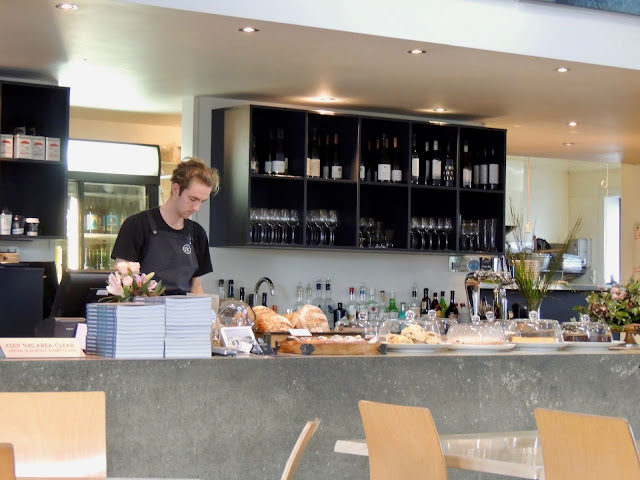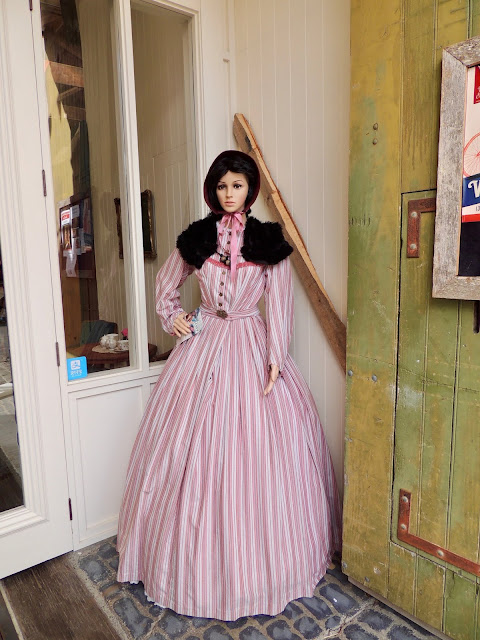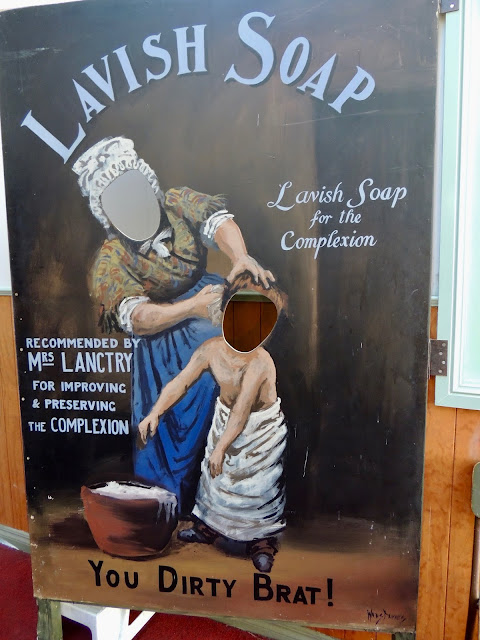15 minutes north of Oamaru is Riverstone Kitchen, which grows most of its own produce. Chef Bevan Smith cooked in Australia and Europe before returning to NZ in 2006 to open Riverstone, built in a paddock on the family farm. In 2010, the resto won Cuisine Magazine's restaurant of the year award.
Riverstone Kitchen isn't in the castle. Its modern structure and interior owe more to Terrance Conran than King Arthur.
Art ordered venison, which tasted like filet and was tender to the knife.
I'm having some dreamy fish, on an enormous mound of mushrooms and a bit of pasta in a flavorful sauce. It's 10:30 am and we're not the first people here (they open at 9). This is my idea of the perfect breakfast.
A beet ferment side to share.
Dessert is lemon tart with a scoop of berry sorbet and two forks.
We're back in Oamaru after a luscious meal.
Much of Oamaru's ornate architecture is attributed to Thomas Forrester (1838-1907):
While still in full time employment with the Harbour Board, for almost three decades from 1872 and in partnership with John Lemon, Forrester designed an impressive portfolio of ornately decorated buildings and family homes, contributing more than any other person to the distinctive architecture of Oamaru.
Oamaru stone, sometimes called whitestone,[1] is a hard, compact limestone, quarried at Weston, near Oamaru in Otago, New Zealand. Oamaru stone was used on many of the grand public buildings in the towns and cities of the southern South Island, especially after the financial boom caused by the Central Otago goldrush of the 1860s. Initially used primarily in Oamaru itself, it became popular in Dunedin in around 1866, with the University of Otago's Registry Building being the first major structure in the city to make use of it.[2]
I believe that second columned building is the Forrester Gallery.
Standing on the cobbled corner of Harbour and Tyne Street, I am cast back 130 years in time among a wealth of historic architectural treasures. There is no evidence of anything other than Victorian architecture. I amble down the lane with its old rail line still running down the side, where trains picked up sacks or grain to be loaded on to bowsprits, spars and fully rigged triple-masters on Sumpter wharf in the harbour.
Poke into some of the cavernous spaces and it's like a stage set or...like 140 years passed in the blink of an eye.
We met an older woman whose job it is to dust and keep these displays clean. I won't lie: these clown people scare me a little.
Other buildings feature period clothing you can try on during a tour.
And actual people dressed to discuss the district. This affable gent found out we were from Chicago and regaled us with stories from his thrilling visit a couple of years ago.
Oamaru’s limestone buildings tell the story of a town built on the prosperity of the 1860s and 1870s, carving an identity in stone that was continued with the architectural styles of the twentieth century. From the Victorian Italianate glory of the warehousing and offices on Harbour and Tyne Streets, to the imposing Classical authority of the banks on Thames Street, to the Moderne design of the Centennial Memorial Restrooms, the streetscape within the Oamaru Historic Area is remarkably intact and distinctive, giving it special significance. Oamaru’s buildings illustrate the archaeology and technologies of working stone, the history of the Oamaru and the development of the town’s cultural identity as it is reflected in the variety of architectural styles and forms, and over time.
Oamaru, the place of Maru to Ngai Tahu, was built on the proceeds from North Otago’s rich bounty of grain and wool. In a single generation from the 1860s wealth, combined with the easy availability of limestone and the inspired designs of architects including Oamaru’s beloved Thomas Forrester, created a distinctive townscape, much of which still remains. Oamaru’s townscape reminds us of the European settlers’ dreams, of making their way in the world and creating their own future. Oamaru Historic Precinct represents that dream: the harbour, the warehousing and commercial precincts centred on Harbour, Tyne, Tees, Itchen and Thames streets – where sea captains, warehousemen, merchants, brokers and bankers bargained and traded – a prosperous town where a person could make good with hard work and a bit of luck.
We visited Adventure Books, home to new, rare, and out-of-print adventure reading, website photo below. I wrote about this shop on another trip, but it's worth repeating because there's a good story here.
Proprietor Bill, who moved to NZ 31 years ago from Texas ("Please don't
hold it against me"), had his original bookstore in Christchurch when
the destructive 2011 earthquakes hit. His shop all but ruined, with a
bit of his collection spared, he said he thought to himself: well,
that's the end of my dream.
And then something remarkable happened. After reading about Bill in the
newspaper, a person from the Victorian Precinct in Oamaru contacted him
and asked if he'd like to move what remained of his collection to town. So he did, and
he's been rebuilding it ever since.
Possum skin books
Another favorite used bookshop, just around the corner.
We browsed but didn't buy. Art's been reading on his ipad but I still love paper.
Oamaru Harbor is glorious, and don't those clouds look painted on? On our last visit we stayed in a campground right on this shore, but to our dismay we found it closed this August so the workers could take their holidays. It's the ideal place for a sunny walk, though, and here we ended our day in one of our favorite NZ towns.







































No comments:
Post a Comment